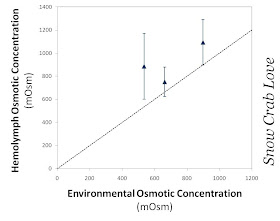Hyas lyratus, with a face only a mother could love
(aw, I love her too!)
our high-tech set-up:
60% seawater on the left, 80% seawater on the right
Any point that falls on the conformer line (the dashed y=x line) represents an animal that keeps their internal osmotic concentration the same as the external environment. A point above the line represents an animal that is regulating its osmolarity.
Just with our little experiment, at 100% and 80% seawater, the lyre crabs appeared to be osmoconformers. Once they were in 60% seawater they began to try to regulate their osmolarity with the hopes for survival. (One female did die in the 60% seawater treatment, but we didn’t have any other mortalities and all crabs were returned to 100% seawater in the wet lab after the experiment).
Lyre crabs just aren’t the regulators like other crabs, for example the green crab Carcinus maenas and Chinese mitten crab Ericheir sinensis. These guys are way better at regulating their internal osmotic pressures: C. maenas has a survival limit at about 33% seawater, and E. sinensis can even survive in fresh water, although they need to be in saltwater to reproduce. I guess that’s part of what makes them such great invasive species (and maybe why we’re NOT seeing lyre crabs all up in everyone’s business).
invasive crabs... what are you gonna do, eh?





No comments:
Post a Comment